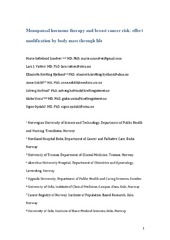Menopausal hormone therapy and breast cancer risk: effect modification by body mass through life
Permanent lenke
https://hdl.handle.net/10037/14971Åpne
Accepted manuscript version (PDF)
Accepted manuscript version (PDF)
Accepted manuscript version (PDF)
Accepted manuscript version (PDF)
Accepted manuscript version (PDF)
Dato
2018-08-06Type
Journal articleTidsskriftartikkel
Peer reviewed
Forfatter
Sandvei, Marie Søfteland; Vatten, Lars Johan; Bjelland, Elisabeth Krefting; Eskild, Anne; Hofvind, Solveig; Ursin, Giske; Opdahl, SigneSammendrag
It is not known whether increased breast cancer risk caused by menopausal hormone therapy (HT) depends on body mass patterns through life. In a prospective study of 483,241 Norwegian women aged 50–69 years at baseline, 7656 women developed breast cancer during follow-up (2006–2013). We combined baseline information on recalled body mass in childhood/adolescence and current (baseline) body mass index (BMI) to construct mutually exclusive life-course body mass patterns. We assessed associations of current HT use with breast cancer risk according to baseline BMI and life-course patterns of body mass, and estimated relative excess risk due to interaction (RERI). Within all levels of baseline BMI, HT use was associated with increased risk. Considering life-course body mass patterns as a single exposure, we used women who “remained at normal weight” through life as the reference, and found that being “overweight as young” was associated with lower risk (hazard ratio (HR) 0.85, 95% confidence interval (CI) 0.76–0.94), whereas women who “gained weight” had higher risk (HR 1.20, 95% CI 1.12–1.28). Compared to never users of HT who were “overweight as young”, HT users who either “remained at normal weight” or “gained weight” in adulthood were at higher risk than expected when adding the separate risks (RERI 0.52, 95% CI 0.09–0.95, and RERI 0.37, 95% CI − 0.07–0.80), suggesting effect modification. Thus, we found that women who remain at normal weight or gain weight in adulthood may be more susceptible to the risk increasing effect of HT compared to women who were overweight as young.
Beskrivelse
Accepted manuscript version. Published version available at https://doi.org/10.1007/s10654-018-0431-7.


 English
English norsk
norsk